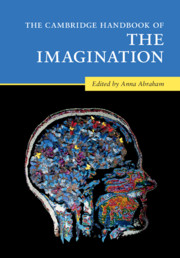Book contents
- The Cambridge Handbook of the Imagination
- The Cambridge Handbook of the Imagination
- Copyright page
- Dedication
- Contents
- Figures
- Contributors
- Acknowledgments
- 1 Surveying the Imagination Landscape
- Part I Theoretical Perspectives on the Imagination
- Part II Imagery-Based Forms of the Imagination
- 12 The Visual Imagination
- 13 Musical Imagery
- 14 Neurophysiological Foundations and Practical Applications of Motor Imagery
- 15 Temporal Mental Imagery
- 16 Emotional Mental Imagery
- 17 Multisensory Perception and Mental Imagery
- 18 Evocation: How Mental Imagery Spans Across the Senses
- Part III Intentionality-Based Forms of the Imagination
- Part IV Novel Combinatorial Forms of the Imagination
- Part V Phenomenology-Based Forms of the Imagination
- Part VI Altered States of the Imagination
- Name Index
- Subject Index
- References
12 - The Visual Imagination
from Part II - Imagery-Based Forms of the Imagination
Published online by Cambridge University Press: 26 May 2020
- The Cambridge Handbook of the Imagination
- The Cambridge Handbook of the Imagination
- Copyright page
- Dedication
- Contents
- Figures
- Contributors
- Acknowledgments
- 1 Surveying the Imagination Landscape
- Part I Theoretical Perspectives on the Imagination
- Part II Imagery-Based Forms of the Imagination
- 12 The Visual Imagination
- 13 Musical Imagery
- 14 Neurophysiological Foundations and Practical Applications of Motor Imagery
- 15 Temporal Mental Imagery
- 16 Emotional Mental Imagery
- 17 Multisensory Perception and Mental Imagery
- 18 Evocation: How Mental Imagery Spans Across the Senses
- Part III Intentionality-Based Forms of the Imagination
- Part IV Novel Combinatorial Forms of the Imagination
- Part V Phenomenology-Based Forms of the Imagination
- Part VI Altered States of the Imagination
- Name Index
- Subject Index
- References
Summary
Visual imagery can be advantageous in much of cognition, unnecessary (aphantasia), to clinically disruptive (PTSD). It allows us to disconnect our senses from reality and test out virtual combinations of sensory experience. With many methodological constraints now overcome, research has shown that visual imagery involves a network of brain areas from frontal cortex to sensory areas and it can function much like a weak version of afferent perception. Imagery vividness and strength range from completely absent (aphantasia) to photo-like (hyperphantasia). Both the anatomy and function of the primary visual cortex are related to visual imagery. The use of imagery as a tool has been linked to a many superordinate compound cognitive processes. Imagery plays both symptomatic and mechanistic roles in neurological and mental disorders, and some of their treatments. Although many unanswered questions remain, we now have multiple objective methods to investigate imagery, and hence shed light not just on imagery, but on the many reliant cognitive processes
Keywords
- Type
- Chapter
- Information
- The Cambridge Handbook of the Imagination , pp. 175 - 186Publisher: Cambridge University PressPrint publication year: 2020
References
- 3
- Cited by

